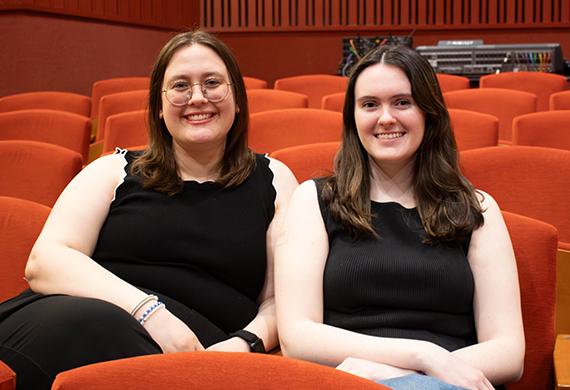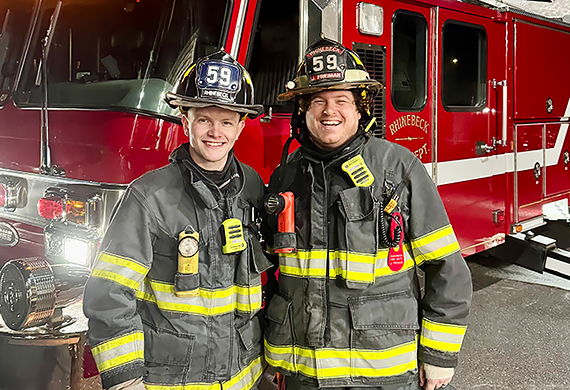Red Fox Spotlight: Emily Yen ’21

July 17, 2019 — Emily Yen ’21 is a fine arts major with a concentration in studio art and a minor in graphic design. She recently lived every artist’s dream by spending a month in Venice, Italy during the world-famous Biennale. The once-in-a-lifetime opportunity to create art in the “Queen of the Adriatic” had a major impact on the Allentown, Pennsylvania native, both personally and creatively.
How did you end up coming to Marist? What’s your experience been like?
A friend of my mom had a niece who had visited Marist and was impressed, so my mom brought me for a visit. I was indifferent to the idea, but as soon as I saw the campus with its beautiful river views, it immediately felt like home. I noticed that all of the buildings were so updated, and the landscaping was immaculate. Plus, I liked the fact that it was easy to switch majors. I initially wanted to major in digital media, but after a year in that program and taking a few studio art courses, I realized that I really wanted to be in the studio, so I switched my major to studio art with a minor in graphic design.
My time at Marist has been great, and I value the relationships I’ve formed with other students and my professors. I’m an editor for the student newspaper The Circle, where I serve as a Chief of Graphic Design. I also attend the Red Ink art club, where we get together to do crafts, socialize, and de-stress. I also just really enjoy the time I spend just working alone in the studio, but at the same time I appreciate the thoughtful critiques and suggestions I receive when my work is viewed by others.
Outside of school, I volunteer at an animal shelter, taking photos of adoptable animals and spending time with the cats. My family recently adopted a mixed-breed dog named Tripp who loves to steal donuts and ribs off the kitchen counter! He also knows “sit” and “roll over” and loves to swim.

Describe the Biennale for those who aren’t familiar with it. How do Marist students participate?
The Venice Biennale is a bi-annual exhibition of artwork from around the world, consisting of various “pavilions.” Some pavilions represent a mixture of artists from various nationalities, while others function as national pavilions, i.e., pavilions representing an individual nation such as the United States, Canada, Venezuela, etc. The Marist Biennale Program allows Marist students to study the Venice Biennale and all the work that’s a part of it in order to further our own work as artists. The majority of our time is spent working in the studios, which feels more like graduate school because we’re free to come and go as we please. Otherwise, we’re viewing the Biennale exhibitions, having discussions in art history, or exploring Venice on our own.
How long were you in Venice and how did you spend your time?
I was in Venice for about a month, and apart from the actual program and being in the studios or class, I enjoyed just wandering around and getting lost in the city. You find so many amazing things when you’re not looking for anything in particular. Plus, Venice feels completely safe, so I felt really comfortable exploring.
Describe the art project you worked on there.
Initially, I had no idea what I wanted to work on. I knew I wanted to do something that was based on Venice and my experiences that month. But, did I want to draw? Did I want to paint? Did I want to sculpt? Lacking a clear direction, I actually I started off by making paper, which continued my recycled objects theme (during the previous spring semester, I had worked with plastic bags as my chosen medium). Ultimately, I found myself inspired by St. Mark’s Lion, the symbol of Venice. I ended up creating a series of drawings of winged lions on handmade paper.

How did the experience of being in Venice during the Biennale influence you as an artist?
I think that being in Venice during the Biennale influenced me as an artist considerably, as I am realizing new possibilities and new definitions of what art can be. To be in Venice is to be surrounded by art in every aspect, and from all different times. It allows for a unique fusion of classical and contemporary art coming together, and that fusion inspires growth in my own work.
What was the role of the faculty in helping you bring your work to fruition?
[Professor of Art] Ed Smith is incredible; I can’t really put it any other way. He helps you develop as an artist without you even realizing it, by teaching you different techniques and analyzing your work in a way you had never considered. For example, he saw my lion drawings as a synthesis of some other artistic challenges I had been working through back in Poughkeepsie; it was a combination of my appreciation of the process of creating art, my search for my own artistic voice, and other animal studies I had been working on. But honestly, Ed and all the other faculty members help us the most by just making sure that we have everything we need to succeed, whether it’s material or just someone to talk to and bounce ideas off.
What are your thoughts on what you want to do after college?
At this moment in time, I think I’d like to get my master’s degree in some form of art so that in the future I can teach art at the collegiate level. But another realization after being in Venice is that the world is a very large place full of so many different possibilities and opportunities. So, if some other opportunity arises, I might just take it! Determination and ambition are both traits that run in the Yen family, and I’m no exception. Whatever I end up doing, I want to be great at it.




